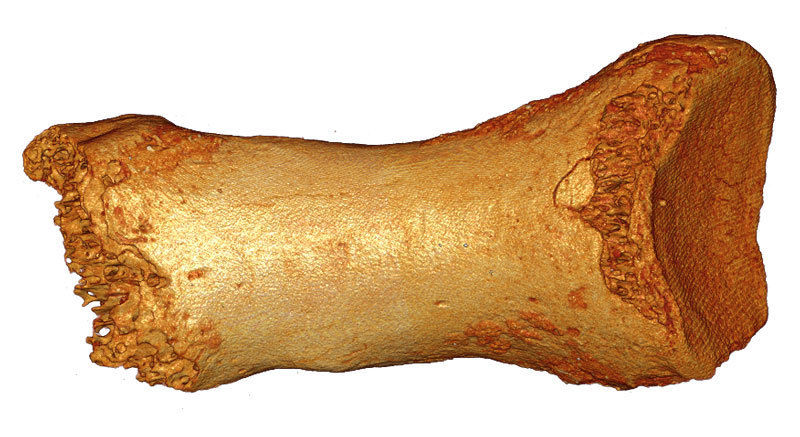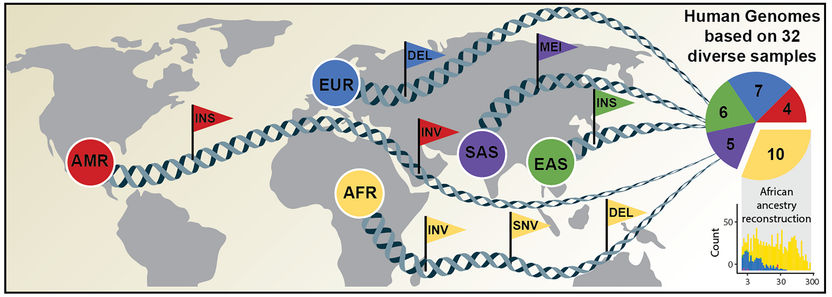Neandertal genome project reaches its goal
High-quality Neandertal genome provides novel insights into human origins
An international research team led by Kay Prüfer and Svante Pääbo of the Max Planck Institute for Evolutionary Anthropology in Leipzig, Germany, has determined a high-quality genome sequence of a Neandertal woman. The genome allows detailed insights into the relationships and population history of the Neandertals and other extinct hominin groups. The results reveal that gene flow among such groups was common but generally of low magnitude. It also provides a definitive list of the DNA sequence changes that distinguish modern humans from our nearest extinct relatives.

The high-quality genome sequence was generated from this small Neandertal toe bone.
© MPI f. Evolutionary Anthropology/ B. Viola
In 2006, Svante Pääbo of the Max Planck Institute for Evolutionary Anthropology in Leipzig, Germany, initiated a project to sequence the Neandertal genome. In 2010, this project which is funded by the Max Planck Society produced a draft genome sequence which revealed that Neandertals had contributed genes to people who today live outside Africa. It also resulted in the discovery of a new group of extinct humans, the Denisovans, who were related to Neandertals and who contributed genes to present-day people in Oceania. The project has now culminated in the production of a high-quality Neandertal genome sequence where each position has been sequenced on average 50 times over. The unique portion of the genome that was reconstructed is of a quality at least as high as that of genomes sequenced from present-day people.
The toe bone used to produce the sequence was found in 2010 by a team of Russian archaeologists, led by Anatoli Derevianko and Michael Shunkov of the Russian Academy of Sciences, in Denisova Cave in Southern Siberia, and is approximately 50,000-year-old. The high-quality Neandertal genome refines and extends our understanding of how Neandertals are related to present-day people and to other extinct groups. According to the researchers’ new estimates the fraction of Neandertal-derived DNA in the genomes of people outside Africa varies between approximately 1.5 to 2.1 percent. The new data also shows that approximately 0.2 percent of the genomes of mainland Asians and Native Americans is of Denisovan origin.
With the high quality sequences of both a Neandertal and a Denisovan, it is for the first time possible to look for signs of interbreeding among extinct hominin groups. This reveals that Neandertals contributed at least 0.5 percent of their DNA to the Denisovans. In addition, the Denisovan genome differs from the Neandertal genome in that it contains about 2.7 to 5.8 percent of the genome of an unknown archaic hominin. “This ancient population of hominins lived prior to the separation of Neandertals, Denisovans and modern humans”, says Kay Prüfer. “It is possible that this unknown hominin was what is known from the fossil record as Homo erectus. Further studies are necessary to support or reject this possibility.”
When analyzing the genome the researchers noticed that the parents of the Neandertal individual must have been closely related to each other. “We performed simulations of several inbreeding scenarios and discovered that the parents of this Neandertal individual were either half siblings who had a mother in common, double first cousins, an uncle and a niece, an aunt and a nephew, a grandfather and a granddaughter, or a grandmother and a grandson”, says Montgomery Slatkin, a population geneticist at the University of California at Berkeley who led some of the analyses of the genome. Further analyses suggest that the population sizes of Neandertals and Denisovans were small and that inbreeding may have been more common in Neandertal groups than in modern populations.
Using the high-quality Neandertal genome the Leipzig team has now established a definitive genome-wide catalog of sites where present-day human genomes all carry the same nucleotide but differ from the Neandertal, Denisovan and great ape genomes. “This list of simple DNA sequence changes that distinguish all humans today from our nearest extinct relatives is comparatively short”, says Svante Pääbo, director at the Max Planck Institute for Evolutionary Anthropology. “It is a catalog of the genetic features that sets all modern humans apart from all other organisms, living or extinct. I believe that in it hide some of the things that made the enormous expansion of human populations and human culture and technology in the last 100,000 years possible”.
























































